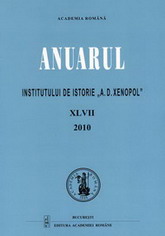Primele studente ale Facultăţii de Litere de la Universitatea din Iaşi
First Female Students in the Faculty of Letters of the University of Iaşi
Author(s): Leonidas RadosSubject(s): History
Published by: Editura Academiei Române
Keywords: University; female student; Faculty of Letters; academic specializations; traditional duties
Summary/Abstract: The process of female students’ admission in the University of Iaşi is generally synchronous with the similar processes elsewhere in Europe, with two major preconceptions to overstep: the woman would be intellectually inferior to the man and the instructed woman would neglect her traditional duties as part of the family. In the case of the city of Iaşi, the admission of the young women to University was facilitated by the local less effervescent environment, and by the general impression that this was to represent the new European tendency, an opposition to the trend being meaningless. We should also mention here the wide support that the first female students enjoyed in the pages of the Contemporanul, the magazine of the socialist organization of Iaşi, or in the pages of the feminist publications all over the country. If in Switzerland the first female students’ series is dated back to 1865, the first female student registered in the archives of the University of Iaşi is Ana Mănăstireanu-Botta, enrolled as an auditor in the Faculty of Letters in 1879-1880; after her, in the years to come, followed other mates in Sciences, Medicine and Letters. From this point of view, the local University stands higher than other institutions, especially from the German world, where the process of female students’ admission was delayed until the beginning of the 20th century; this is a telling element for how hard the principle of co-education and equal rights to higher studies has been accepted. For the period until 1894-1895 (included) we have data regarding a number of 74 female students in Letters, out of a total amount of 531 students, that is a rate of 14%. The rate consistently rises in the following years: 38% in 1895-1896 (25 female students out of 63 students) and 48% in 189-1897 (47 female students out of 102 students). The high number of female students in the Faculty of Letters, especially at the end of the 19th and the beginning of the 20th century, when it almost equals the men’s number, clearly betokens a preference for the profession of teacher in the secondary education system; there is no other explanation for the massive inclination to this specialization, especially as the chance to get a scholarship here was smaller than it was in the case of other academic specializations, like Sciences and Medicine. We will surely not exclude from this equation other variables, such as the horizon of expectations of the male society or the increased compatibility of the lectures delivered in the Faculty of Letters with the spiritual universe of the young women at the end of the 19th century.
Journal: Anuarul Institutului de Istorie »A.D. Xenopol« - Iaşi
- Issue Year: XLVII/2010
- Issue No: 47
- Page Range: 49-72
- Page Count: 24
- Language: Romanian

